You think it's hot in Las Vegas? Just travel a few hours to Death Valley where the extreme heat met new heights in June.
While Las Vegas hit a few records in June, Death Valley ended up well exceeding its average temperature for the whole month.
Last month was the hottest June on record in Death Valley National Park, with a sweltering average temperature of 101.9 degrees. June 2016’s temperatures exceeded average June temperatures by about 6 degrees.
The average of 95.5 degrees had been recorded over the past 105 years. Official weather observations have been recorded at Furnace Creek since 1911.
Death Valley’s average daily high temperature this June was 115.5 degrees and the average overnight low was 88.2 degrees. In spite of a record-setting average temperature, Death Valley only set a new daily record one day last month, with 126 degrees recorded on June 21.
The highest temperature ever recorded in Death Valley in June was just a few years ago: 129 degrees on June 30, 2013.
June isn't even the hottest part of summer with hotter temperatures expected in July and August.
“The average temperature sounds hot enough, but when you break it down you can really understand the extreme summer conditions in Death Valley. People expect a desert to cool down at night, but the night of June 21 only cooled down to 101 degrees Fahrenheit,” said Superintendent Mike Reynolds in a news release.
Death Valley holds the record for highest officially recorded temperature on the planet: 134 °F on July 10, 1913.
Another way to look at summer temperatures in Death Valley is to count the number of days that temperatures reach or exceed a certain threshold. Death Valley reaches a daily high of at least 90 agrees on an average of 190 days — about half the year.
Death Valley’s daily high is at least 100 degrees an average of 140 days annually, at least 110 degrees an average of 89 days per year, above 120 degrees an average of 18 days per year and at least 125 degrees an average of 3 days per year. So far this summer, Death Valley has already reached 120 degrees on eight days.
The heat doesn’t keep visitors away from Death Valley National Park.
“Death Valley National Park receives more summer visitation than you might expect. August is the park’s third busiest month, behind only March and April," Reynolds said. "Many of these visitors are from other countries and they come here to experience our world-famous extreme temperatures."
But visitors should stay safe on Death Valley roads in the summer, staying on paved roads and not walking long distances. Other tips are to wear a hat, light-colored and loose-fitting clothing, and to drink plenty of water. Humidity in Death Valley is usually very low, often below 10 percent.
While most visitors come to see famous low elevation sites like Badwater (282 feet below sea level), some of the best areas of the park to visit in summer are at high elevations. Hikes to Wildrose Peak (elevation 9,064 feet) and Telescope Peak (elevation 11,049 feet) are best done in warmer months when they are not covered in snow.
High overnight temperatures make sleeping at Furnace Creek Campground unbearable for most people in summer, but temperatures at Wildrose Campground (elevation 4,100 feet) and Mahogany Flat Campground (elevation 8,200 feet) are quite comfortable.
Information about Death Valley’s climate history is available online.



